When someone asks, “What does RV stand for?”, most people would probably reply with the semantic definition by noting that “RV” is technically an abbreviation that stands for “recreational vehicle”. But the term “RV” has become a word of its own…
“RV” can be a noun, as in “We love our RV!”
Some people use “RV” as a verb, as in “We love to RV!”
And we can extrapolate all sorts of other words. For example, the word “RVer”, meaning a person who RVs! Or the word “RVing”, meaning traveling in an RV.
But, to offer the deeper answer to the question “What does RV stand for?” is where we plow into the vast details of what the term “recreational vehicle” means.
And that’s what we’re doing in today’s post! Ready to bag the semantics and get into the nitty gritty?
Let’s go!
What Is a Recreational Vehicle?
We’ve already established that the term “RV” stands for “recreational vehicle”. But the “RV” meaning applies to many different types of vehicles!
In general, an RV is a home-on-wheels. It can be used as a camping vehicle, a vacation vehicle, a toy hauler, or a home away from home. Or it can be a full-time home as ours has been for us for the past 20 years or so.
So, although there are many different types of RVs, and although the RV lifestyle means different things to different people, every recreational vehicle is a type of living quarters on wheels that allows you to take a home onto the open road and travel to various places while living in it!
Let’s take a look at the various types of recreational vehicles…or RVs!
Motorized RVs
In the category of motorized RVs there are several different classes of recreational vehicles. We’ll start with the largest of the bunch and work our way down to more compact motorhomes.
Class A Motorhome
While Class A RVs aren’t the absolute biggest rigs on the road, they’re certainly among the largest and many qualify as “big rig RVs“. Built on a single chassis, a Class A RV could have one, two, or three axles. They can be anywhere from 26′ to 45′ long.
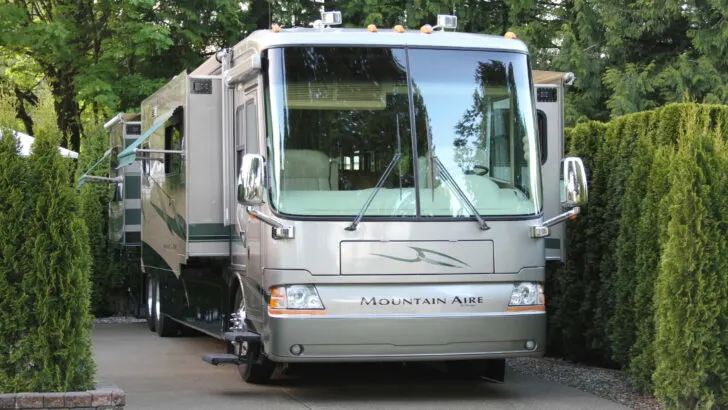
Our RV is a 43-foot Class A diesel pusher, but some Class A recreational vehicles are as short as 26′.
A Class A motorhome is large enough to have a full kitchen with (mostly) full-sized appliances, a large separate living area, a full bathroom, and at least one large bedroom. Depending on the floorplan, Class A rigs can have more than one bathroom and even more than one bedroom! For much more information, see our post, “What Is a Class A RV?”
Class A RVs are typically built on a heavy-duty frame like commercial trucks and buses, though the components (axles, wheels, tires, transmission, etc) are usually customized to suit the requirements of the RV manufacturer.
Our own personal RV was a 43′ diesel pusher, but there are some very nice small Class A motorhomes out there as well.
Above and beyond the classification of an RV as a “Class A”, you can further segment them based on the fuel (and, thus, type of engine) they use… or where the engine is placed on the chassis:
Gas RV
A gas-fueled Class A rig will have an engine in the front.
Diesel Pusher
A diesel pusher, on the other hand, has a diesel engine in the rear of the rig, essentially “pushing” the RV forward.
Class B RV
In our post on the benefits of smaller RVs, we discussed at length the Class B RV which is the smallest motorhome that sits in a class of its own.
Class B rigs have all the amenities of a full-fledged RV, but in a smaller package that many people prefer because they tend to be easier to drive. In fact, a Class B RV can usually be parked in a regular parking space.
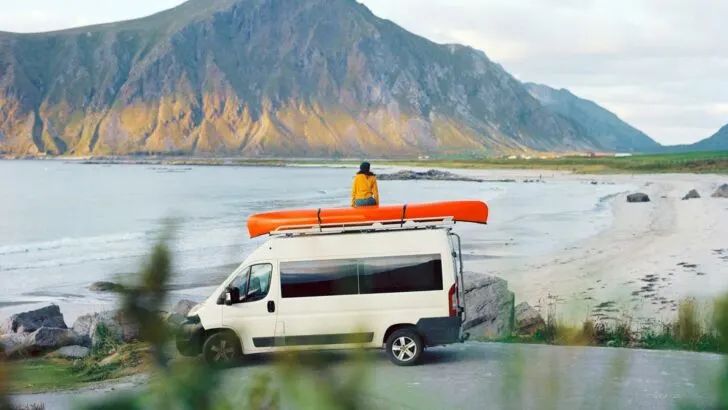
A Class B RV is a fully self-contained recreational vehicle that is so compact that it can fit into a standard parking spot!
Although Class B motorhomes have amenities such as a kitchen, bathroom, and sleeping quarters, everything is far more compact. This means that fewer people can travel in Class B RVs… and it means that all of these amenities are compacted into a much smaller space.
For this reason, you’ll find that many Class B RVs have RV wet baths as opposed to a bathroom with a separate shower and toilet/sink area. In a wet bath, these amenities are all rolled into one which means that when you shower, the toilet and sink get wet.
Still, a Class B RV allows people to travel to some fantastic locations, park just about anywhere, back into any campsite with ease, and get some pretty great gas mileage!
Class B+ RV
In case you’ve read about a “Class B+ RV”, we’ll mention it here, though it’s not really a true RV class of its own, but more of a marketing term. In fact, based on federal regulations, a so-called “Class B+ RV” is technically a Class C RV.
A Class B+ RV is different from a traditional Class C RV because it doesn’t have a cabover bunk that runs over the front/hood of the chassis. Instead, a Class B+ RV is built on a truck chassis but has a separate cab.
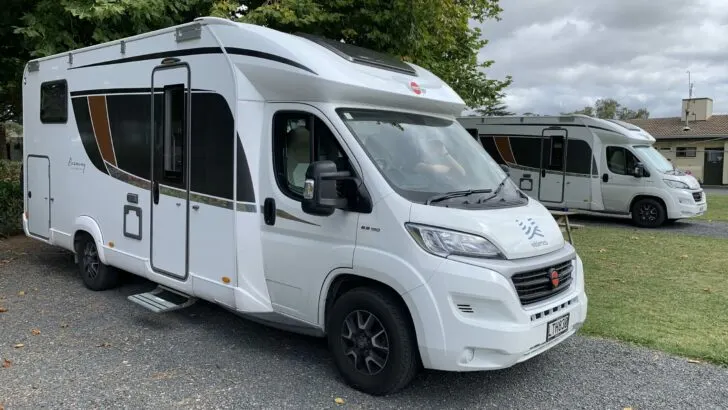
Our Class B+ rental in New Zealand parked near the Class B+ rig rented by our friends, Tom & Cait Morton.
For much more information on rigs that are called “Class B+ RVs”, see our post, “What Is a Class B Plus RV?” You’ll even get a look at a Class B+ we’ve rented when traveling overseas.
Class C RV
As we mentioned above, you can often distinguish a Class C rig by the overhang that sticks out over the driver’s area, which is either a cabover bunk for sleeping or a space for an entertainment center and storage.
A Class C RV is built with a cab or cutaway chassis. So, the front takes on the appearance of a van while the house offers more living space and more storage.
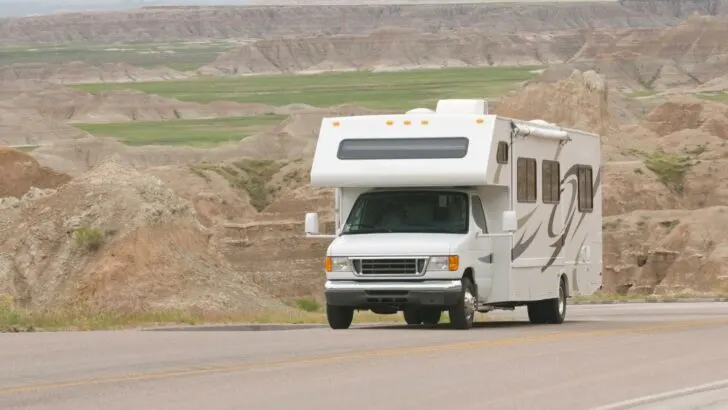
A Class C RV is identifiable by the distinct cabover feature that sits over the driver’s cab.
Class C RVs vary significantly in size within the classification, running anywhere from 21 feet to 41 feet in length. You can check out our post on the best Class C RVs under 30 feet for a glance at the Class C rigs that fall right in the middle in terms of size.
And if you’re interested in finding out what a Super C RV is (yeah, it’s another marketing term but they’re pretty cool and well worth seeing), have a look at our post, “What Is a Super C RV?” These big boys are “big rigs”, too… many with the same amenities and luxuries of a Class A Diesel Pusher, but in a front-engine design.
Camper Van/Van Conversions
Camper vans and van conversions are traditional vans that are converted into campers either professionally or in DIY fashion.
Camper vans aren’t always fully self-contained, although many are, with some even having some type of shower (often outside) and a toilet. (See our post “RV Toilet Talk: 5 Types of RV Toilets and How They Work” for more information on a couple of types of toilets that might work in a van conversion.)
Camper vans are easy to drive, easy to park, and easy to maneuver into a compact parking space. Many people appreciate traveling in a camper van due to the stealth factor that allows them to park almost anywhere without notice.
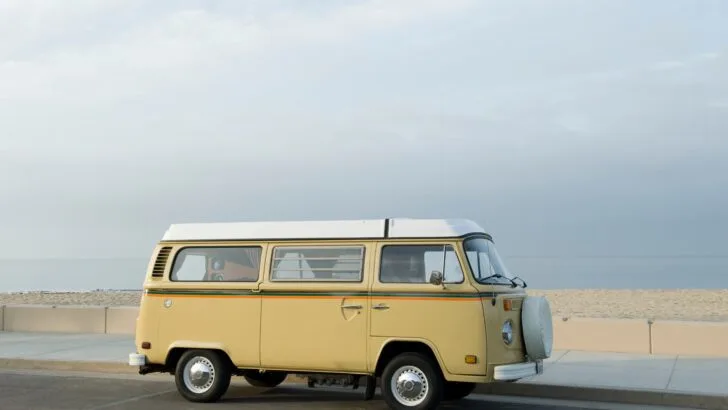
A camper van, like this classic VW, is a small RV that’ll fit into a regular parking space.
Still, camper vans and van conversions are RVs… recreational vehicles! Some camper vans are even designed to travel in the backcountry with off-roading/4×4 capabilities.
Towable RVs
Towable RVs are a classification of recreational vehicles that are non-motorized. Towable rigs find the “house” portion of the RV built on a chassis that’s towed by a separate tow vehicle (usually an SUV or pickup truck, depending on the size and weight of the towable).
There are a number of different types of towable RVs. Among them are the following.
Travel Trailer
Travel trailers are the best-selling RVs on the road, partly due to the fact that they’re less expensive to purchase, and they offer such a wide variety of sizes and options.
Another reason why RVers love travel trailers is the fact that you can park a travel trailer at your campsite and get settled in, then unhook your tow vehicle and use it to travel around the area. This is a great feature of all types of travel trailers.
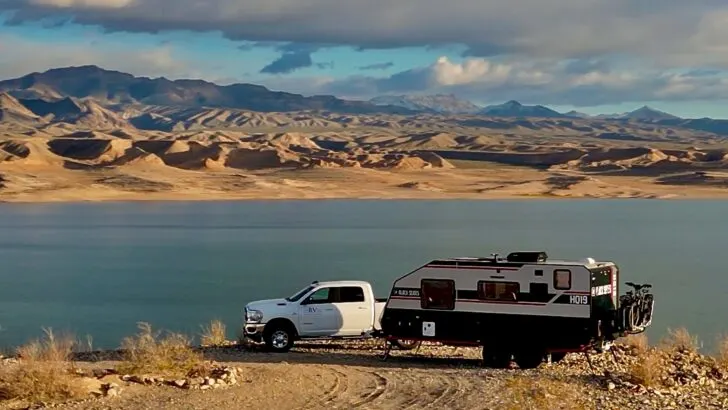
Our Black Series HQ19 travel trailer detached from the 4×4 pickup-truck used to tow it. Now we can take off in the truck and explore!
As we write this, we’re traveling the desert southwest in a Black Series camper, (the HQ19), a fantastic off-road capable travel trailer that we’re towing with a 4-wheel drive pick-up truck! What a blast (and what a change)!
To see some other great RVs with off-road capabilities, check out our post on off-road RVs!
5th Wheel
There are a number of differences between a 5th wheel and a travel trailer, but the main difference is found in how the towable RV connects to the tow vehicle.
A travel trailer connects to a bumper-level hitch whereas a 5th wheel connects to a hitch that lies in the bed of the truck that tows it.
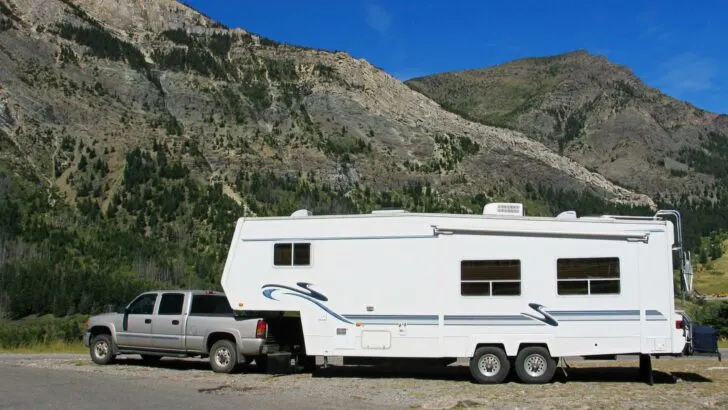
Note the overhang of the 5th wheel above the hitch the bed of the truck towing it.
Another big difference between a 5th wheel and most other travel trailers is that 5th wheels are usually large RVs with lots of room for people and storage. You might say they’re the Class A/Super C RV of towables. Some 5th wheels have multiple bedrooms and bathrooms, in fact, and some even have more than one story!
Visit our post for lots more differences (33 to be exact!) between travel trailers vs 5th wheels.
Pop-Up Camper
A pop-up camper, sometimes called a tent trailer or fold-out camper, is an RV that has collapsible, tent-like roof and walls. These are some of the smallest, and lightest, travel trailers on the road.
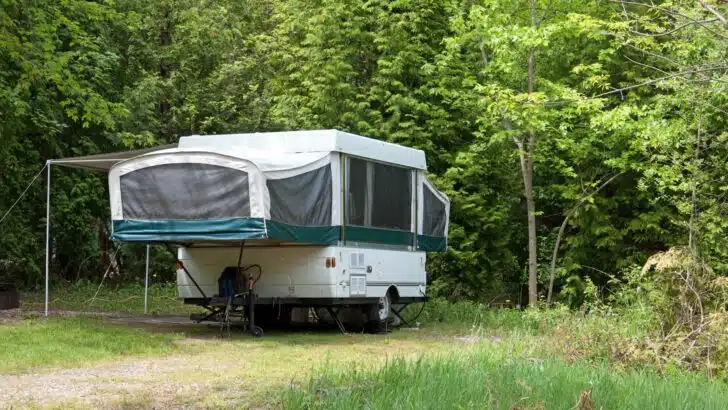
This is a typical pop-up camper. Here you see the roof and sides deployed for camping. The sides retract and the roof collapses to make towing this small camper a breeze.
The walls of a pop-up camper are partly made of fabric and they usually have screen windows. They also often have beds that extend out each end of the camper in tent-like fashion, dramatically increasing the living space from their collapsed footprint.
Truck Campers
Although truck campers are often considered to be travel trailers, they’re really in a class of their own. They aren’t motorized and require a truck to carry them around, but they’re not towable RVs either, since they have no wheels/axles of their own.
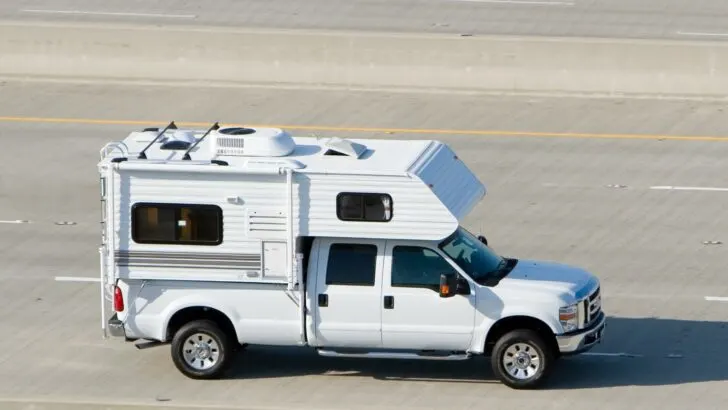
A pickup truck hauling a truck camper.
A truck camper is an RV that sits on the bed of a pick-up truck and is carried to its destination on the “back” of the truck. Once the RVers have reached their camping destination, the truck camper can be removed from the bed of the truck, sitting on its own leg extensions.
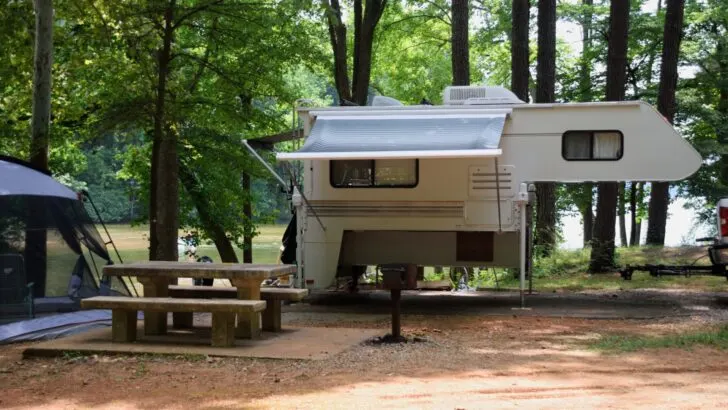
A truck camper at a campsite, detached from the truck that hauled it to this location.
This way it can be left at the campsite while the truck is used to explore, shop, and seek entertainment, recreation, or dining opportunities in the area.
So, What Does RV Stand For?
RV stands for LOTS of different types, shapes, and sizes of recreational vehicles that take us down the road, off the road, and on excellent adventures to pursue the things we enjoy, all while living in a little (or big!) home on wheels!
Free RVing Tips, Tricks, Reviews, Giveaways & More
Subscribe to our daily newsletter! We’ve been full-time RVers for 20 years (!) and share everything we’ve learned about RVing in our daily blog posts. Join our online community to receive a wealth of great RVing knowledge delivered right to your inbox.
Whether this is your first time on the road or you’re a seasoned full-timer, you’ll love the wide range of RVing topics we cover. Don’t miss a single article or any of our famous RV gear Giveaways — Subscribe today!


John S.
Tuesday 7th of February 2023
Good article about the different types of RVs available.
I've always considered recreation as getting out, moving about, enjoying the outdoors, mostly with company but sometimes alone.
But it seems that every RV park and too many not-official parking areas now have so called "RVs" that have not moved since the last century.
Perhaps it's time to come up with a nice word to describe Recreation Vehicles that no-longer recreate.
Bernie Turner
Monday 20th of March 2023
@TheRVgeeks, On bad days it also stands for Repair Vehicle
TheRVgeeks
Wednesday 8th of February 2023
How 'bout SV's? For "Stationary Vehicles" or maybe "Sedentary Vehicles"?!?! ????????
Gay Travel Enthusiast (Jason)
Tuesday 7th of February 2023
Hey guys. I hope you're having a fun February thus far. I'm familiar with some of these RVs. My oldest brother and sister-in-law recently inherited a Class C Minnie Winnie from her parents. I've slept in the Winnie a few times. It's quite comfy. I'd buy a diesel pusher if I had someone to share the experience with, and if I could find one less than 30' in length.